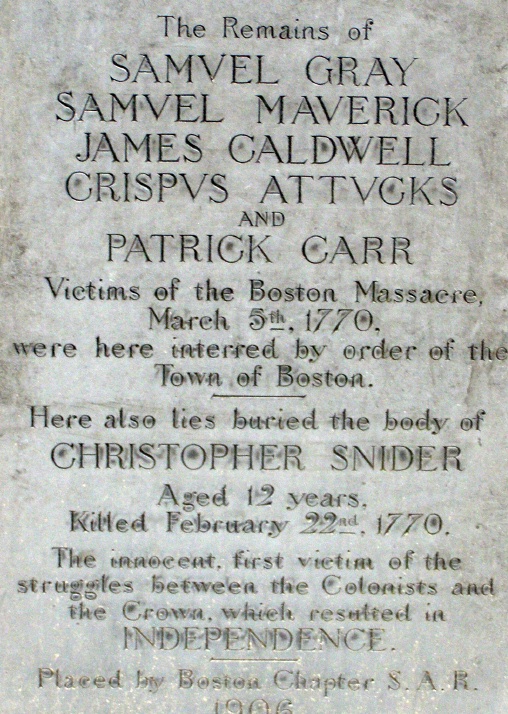Where Was Christopher Seider Buried?
After young Christopher Seider was killed on 22 Feb 1770, where was he buried?
A marker in the Granary Burying Ground (shown here) bears his name under those of the five people who died the following month after the Boston Massacre. But that’s not a contemporaneous marker. It was erected by the Sons of the American Revolution in 1906.
(The stone lists the boy’s name as “Christopher Snider,” a variation which did appear at the time but doesn’t match most family records. It also gives his age as twelve. As I wrote here, Christopher was probably killed shortly before his eleventh birthday.)
Some people have suggested that Christopher’s body was buried somewhere else. In his recent book First Martyr of Liberty, Mitch Kachun posited that the boy was buried under Liberty Tree. That’s based on the description of his funeral as published in multiple Boston newspapers, including the 5 Mar 1770 Evening-Post:
But under Liberty Tree would have been a very unorthodox spot, likely to be clearly mentioned in other sources. Despite that elm’s public symbolism, it wasn’t on public land; it was in the yard of bookbinder John Eliot. No later description of the tree mentioned that it was also a gravesite.
Furthermore, the tree was on a well-traveled corner. There was a old British custom of burying people who had committed suicide at such crossroads instead of in designated graveyards; Parliament finally outlawed that practice in the reign of George IV. In 1770 Boston’s Whigs wanted to present Christopher Seider as an innocent young martyr to liberty, and burying him on unconsecrated land at a crossroads would have undercut that message.
TOMORROW: So if Christopher Seider was interred in a burying-ground, which one?
A marker in the Granary Burying Ground (shown here) bears his name under those of the five people who died the following month after the Boston Massacre. But that’s not a contemporaneous marker. It was erected by the Sons of the American Revolution in 1906.
(The stone lists the boy’s name as “Christopher Snider,” a variation which did appear at the time but doesn’t match most family records. It also gives his age as twelve. As I wrote here, Christopher was probably killed shortly before his eleventh birthday.)
Some people have suggested that Christopher’s body was buried somewhere else. In his recent book First Martyr of Liberty, Mitch Kachun posited that the boy was buried under Liberty Tree. That’s based on the description of his funeral as published in multiple Boston newspapers, including the 5 Mar 1770 Evening-Post:
The Remains of young Snider, the unfortunate Boy who was barbarously murdered the 22d of February last, was decently interred the Monday following. His tragical Death and the peculiar Circumstances attending had touched the Breasts of all with the tenderest Sympathy, a few only excepted, who have long shown themselves void of the Feelings of Humanity. The little Corps was set down under the Tree of Liberty, from whence the Procession began. About Five Hundred School boys preceded; and a very numerous Train of Citizens followed, in the Estimation of good Judges, at least Two Thousand of all Ranks, amidst a Crowd of Spectators, who discovered in their Countenances the evident marks of true Sorrow.I disagree with Kachun’s reading. The report mentions “the Tree of Liberty” as the start of the funeral procession, not the end. To be sure, this article didn’t state where the boy’s body ended up.
But under Liberty Tree would have been a very unorthodox spot, likely to be clearly mentioned in other sources. Despite that elm’s public symbolism, it wasn’t on public land; it was in the yard of bookbinder John Eliot. No later description of the tree mentioned that it was also a gravesite.
Furthermore, the tree was on a well-traveled corner. There was a old British custom of burying people who had committed suicide at such crossroads instead of in designated graveyards; Parliament finally outlawed that practice in the reign of George IV. In 1770 Boston’s Whigs wanted to present Christopher Seider as an innocent young martyr to liberty, and burying him on unconsecrated land at a crossroads would have undercut that message.
TOMORROW: So if Christopher Seider was interred in a burying-ground, which one?


2 comments:
That newspaper article says "The little corps was set down under the Liberty Tree,from whence the procession began." The punctuation used indicates that the procession both began and ended at the same spot. The word "corps" was possibly a miss-spelling of "corpse".
Yes, “corps” is definitely a variation on “corpse.” I don’t read the “set down” as meaning “buried.” I think the corpse and coffin were simply set down temporarily under the tree as the procession formed. Organizing five hundred schoolboys would take a little time, after all! Today’s posting followed this item up with more newspaper accounts.
Post a Comment